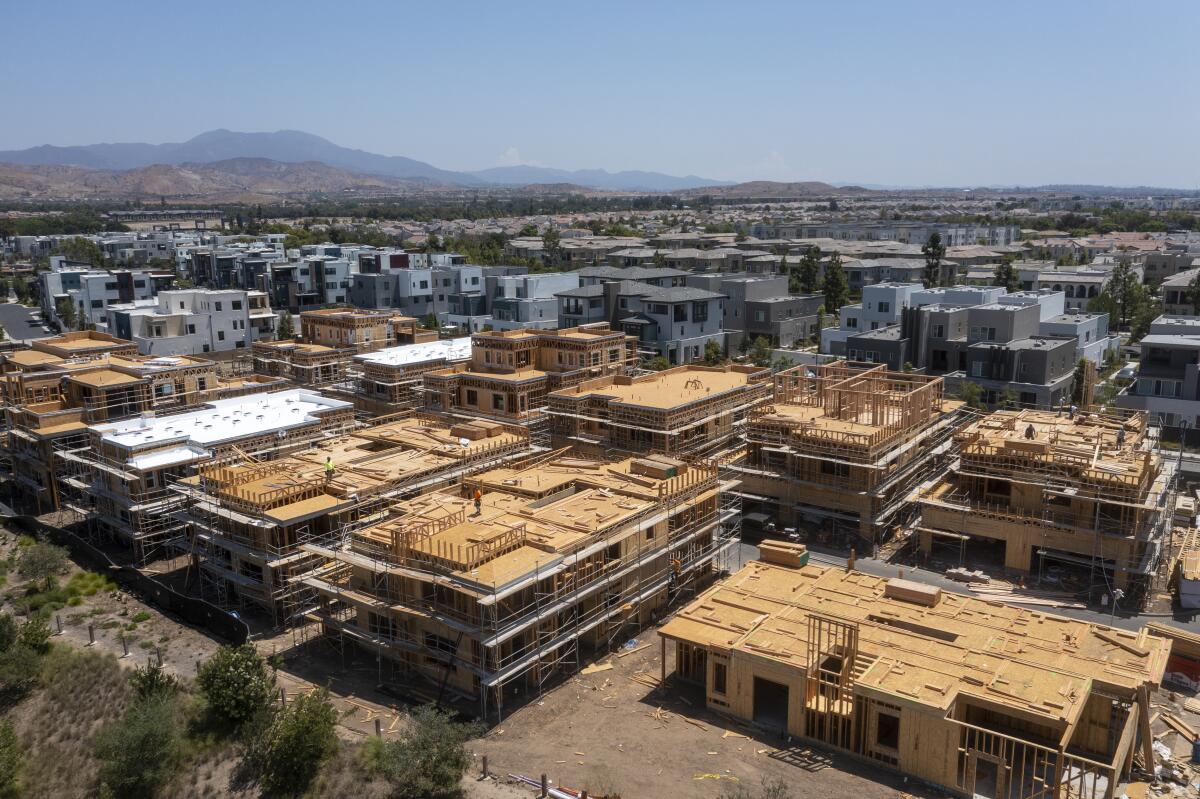The California conundrum: Fewer people, more homes, but an acute housing shortage

In the last decade, California home prices and rents have soared, an upswing that’s put homeownership further out of reach and helped drive thousands into homelessness.
This escalation coincided with a unique moment in California history. For much of the last decade, the state’s population growth was historically low.
In the last few years, it ground to halt and then dropped — and all the while developers continued to build.
Given the laws of supply and demand, one might think fewer people and more homes would equal lower prices. But California housing costs remain stubbornly high and have barely fallen — if at all.
Experts interviewed by The Times said home prices and rents haven’t plunged for several interconnected reasons. But in general, it’s because for decades — even in years of slow population growth — California hasn’t added enough housing to meet demand, creating a backlog so large that it can’t be corrected by a few years of population loss.
Making the situation more acute: a generational bulge of millennials who — in larger numbers than the preceding Generation X — have exploded into a housing market that wasn’t ready for them.
Unable to afford a down payment on a home, a young couple financed a prefab ADU in their parents’ backyard in L.A.
What exactly is happening?
In 2020, the Golden State recorded its first population decline on record and the number of Californians has slipped ever since, according to data from the California Department of Finance.
At the start of 2023, California had nearly 709,000 fewer people than it did in January 2020, while the total number of housing units had grown by nearly 378,000, state data show.
In Los Angeles County, the population started to drop in 2018. Today, there are about 431,000 fewer people and 117,000 more homes in Los Angeles County than five years ago, data show.
John Boyne, a researcher with the state Department of Finance, said that although the state and L.A. County are adding homes and losing population, the trend is probably exaggerated because of data issues that will soon be corrected.
When those are resolved in coming months, Boyne said, the population losses — and to a lesser extent the housing gains — will probably be smaller even though they will still exist.
Although people looking for housing might not notice, the trend of fewer people and more homes has had some effect, experts said. In L.A. County, the median rent for August is 17% higher than at the start of 2018 but is down 2.4% compared with a year earlier, according to data from Apartment List.
The county remained the nation’s most populous. California saw a significant loss of people in several counties, including Santa Clara, Alameda and Lassen.
Nationwide, rent soared 31% since 2018 but is down 1% from a year earlier.
Home prices in L.A. County are up 52% since 2018 but down 2% from the peak last year, according to data from Zillow.
Many renters and aspiring homeowners want big dents in housing costs. But population loss hasn’t been enough, said Hans Johnson, a senior fellow with the Public Policy Institute of California.
He noted that less expensive Rust Belt communities have seen much greater declines over a prolonged period.
Wayne County — home to Detroit — has seen its population plunge 34% since 1970. Gary, Ind., dropped 39%.
L.A. County, on the other hand, has lost 4.2% of its population since its peak several years ago and statewide there are 1.8% fewer people — drops that state number crunchers consider somewhat inflated.
People think the “sky is falling and everyone is leaving California,” Johnson said. “That is not true.”
Total population isn’t the only factor affecting the crisis.
That’s because when it comes to the desire for a house or an apartment, not everyone is created equal. A newborn baby doesn’t want their very own housing unit, but in 20 years they probably will.
L.A. County could have 1.7 million fewer people by 2060. It’s not only because residents are leaving
The state population is expected to be flat over the coming decades for the first time in California history. See which counties will gain and lose people.
If one particularly large generation enters their 20s at the same time, the demand for housing can soar even if the total population stays the same, or declines slightly.
That’s exactly what happened with the millennial generation over the last decade and a half, said Dowell Myers, a professor of policy, planning and demography at USC. Noticeably bigger than the preceding Generation X, millennials ignited demand surges that sharply lifted housing costs despite subdued population growth since the Great Recession.
Between 2009 and 2014, a very large cohort of millennials was in their 20s, a prime time for renting your first apartment, Myers’ research shows. In the years since, those millennials have increasingly entered their 30s, when many people in California buy a home for the first time.
The nation’s economy further amplified the millennial effect, Myers said.
The Great Recession not only hammered housing construction but also delayed many millennials from striking out on their own. When job prospects improved, those people jumped into the rental market, and later the for-sale market, at the same time as younger millennials who could afford to follow a more traditional timeline.
Many Californians in the counties with the most affordable housing will be most at risk for extreme heat in the decades to come, according to a Times analysis.
In effect, this created a bulge on top of a bulge at a time when housing construction was still far below pre-recession levels. Myers called it a “double bang.”
To some extent, the current level of housing construction serves as a lid for how many people live in California, because there’s a limit to how much people can, or want to, cram together into one unit.
But there’s still high demand to live in a state with a temperate climate, diverse economy and 1,200 miles of coastline.
So the rich tend to win out, experts said, grabbing the housing that does exist and, in the process, gentrifying older low-income neighborhoods as affluent couples or singles move into apartments formerly occupied by larger families that left for cheaper housing elsewhere.
In such a scenario, an area’s population immediately declines, but the demand for housing does not.
“The cost of living in California and Los Angeles is so high ... that we know a lot of people can’t move here and we know a lot of people can’t remain here, because they are priced out,” said Michael Lens, an associate professor of urban planning and public policy at UCLA.
The public tends to blame homelessness on poverty, drug use, crime or even warm weather. But other cities don’t have L.A. levels of street homelessness because they have more available housing.
Other factors also contribute to rising — or constant — housing demand as the overall population drops, according to the Public Policy Institute’s Johnson.
Some might be short-lived. As the pandemic continues, many young adults — tired of being cooped up with others and armed with stimulus checks — have moved out of shared living situations and found places of their own.
On a long-term basis, birth rates have fallen, people are delaying marriage and the population is aging — all factors that tend to reduce the number of people living in one unit.
Johnson’s research found that since 2020, many large California cities — including gentrification hotbeds of Los Angeles and Oakland — have lost population, but the number of occupied housing units has actually increased.
Just how far behind are we on housing construction?
There is no universally accepted measure, but throughout the years multiple studies have found California hasn’t built enough.
According to the state Legislative Analyst’s Office, California added about 120,000 homes each year between 1980 and 2010 and saw median home prices grow from 80% higher than the nation to 100%, twice as expensive. For median prices to have stayed just 80% higher than in the U.S. as a whole, California needed to build at least 70,000 more homes annually than it did, the study found.
See which California cities are the most costly to live in. Several studies agree: The premium to live in California may be 40% to 50% over the national average.
That would be a total of 190,000 new homes each year. Construction has picked up lately, but since 2010, the high-water mark was still just 123,350 new units in 2022, according to the Department of Finance. Most years came in at fewer than 100,000.
Although demographic experts say population is an imperfect measure of housing demand, it clearly plays a role. Despite the most recent population declines, California still has more people than it did in 2010 and far more than 1980.
“A couple of years of population loss is not going to be enough to offset three decades or more of undersupply,” said Brian Uhler, a deputy with the Legislative Analyst’s Office.
Could there be non-demographic and construction factors contributing to rising housing costs at a time of little or no population gain?
Yes. The rise of short-term rentals has taken some homes off the traditional housing market, and tenant advocates in recent years have raised concerns that large corporations are gobbling up an increasing share of the housing stock.
Jordan Ash, a research director with the Private Equity Stakeholder Project, said large companies demand a quicker and greater return than mom-and-pop landlords and use analytical pricing software to push rent as high as they can — even if it results in a few more vacancies.
“It’s not just a supply issue,” said Ash, who advocated for more expansive rent control.
Johnson said corporatization could be driving up housing costs to some extent, but he said the main reason for the escalation is that California hasn’t built enough to meet demand.
“There are three primary solutions” to our housing crisis, Johnson said. “One, build more housing. Two, build more housing. Three, build more housing.”
What will happen next?
It’s unclear. Predicting that requires a variety of assumptions on construction, birth rates, immigration policy and numerous other factors.
According to preliminary projections from the state Department of Finance, Los Angeles County’s population is expected to decline each year to at least 2060, when it will be nearly 18% lower than today, with the largest declines occurring in the later years.
California’s population is expected to resume growing in 2024, the forecast finds. Then in 2045, it should decline each year to end 2060 about where it is today.
Walter Schwarm, the department’s chief demographer, said both forecasts predict people will move out of L.A. County and California at rates similar to pre-pandemic levels, while low rates of international migration persist. What’s different is when the baby boomer generation starts to pass away, there probably will be too few babies born to replace them — hence why most population loss occurs in later decades.
Schwarm said Census Bureau data released last week indicate that L.A. County might see a slightly smaller decline than 18% by 2060, but the population loss should still be significant.
Myers of USC called the department’s forecast unlikely, in part because he believes international migration will increase, the birth rate will tick up and the state’s diverse economy and natural resources will still attract a fair number of workers from other states.
Even so, Myers predicts some relief for renters. Apartment supply is expanding at a time when millennials are aging into homeownership and a smaller Gen Z is entering the rental market.
“The problem is not solved, but it’s moving in the right direction if you are a tenant,” Myers said.
He expects less of a generation impact on home prices.
Baby boomers will leave behind homes when they pass away, but there are currently more millennials than boomers, and Myers said there just might be enough backlogged demand for homeownership from Generation X, millennials and Gen Z to largely backfill those vacated homes.
“Everyone who is a renter who is middle class is aiming to be a home buyer,” Myers said. “So all the demand is moving toward home buying.”
More to Read
Subscriber Exclusive Alert
If you're an L.A. Times subscriber, you can sign up to get alerts about early or entirely exclusive content.
You may occasionally receive promotional content from the Los Angeles Times.

















